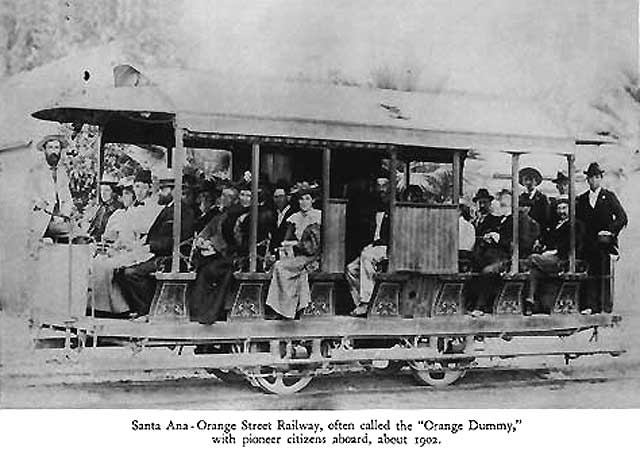Return to ERHA homepage
 Pacific Electric
Santa Ana-Orange Line
Pacific Electric
Santa Ana-Orange Line
Introduction:
This short and unimportant line has historical color all out of proportion to its geographical status. It was one of the first Southern District lines built; it operated two unique cars: a steam propelled vehicle and a gasoline operated one--both rebuilds of early open cable car trailers. For a short time it boasted through service to 6th & Main with heavy interurban cars. But for the most part Santa Ana-Orange was just about as Toonerville an operation as one could encounter on the proud Pacific Electric.

Route:
From Southern Pacific Station Santa Ana, via Fourth, Main and private way to Orange where it terminated at PE Station on Lemon Street.
Mileage:
- Santa Ana Southern Pacific Station 0.00
- Hargraves 2.93
- Orange 4.04
History:
Constructed by Santa Ana, Orange & Tustin Street Railway Company in 1886-1887 as a horse car line between the Plaza in Orange and Fourth & French Streets in Santa Ana.
On January 4, 1897, this company was sold to The Santa Ana & Orange Motor Company, and motor operation commenced during early 1897. This company in turn sold the line to The International Railway Company which operated it regularly as a motor road; on December 5, 1901 the line was sold to Old PE, which in turn deeded the line to LAIU on July 1, 1904. During all these ownerships, the line continued to operate as motor road.
LAIU in 1905 and 1906 abandoned the lightly constructed (25 lb. rails) motor road between the SP Station and the north end of the bridge over Santiago Creek on Main Street, replacing this segment with an electric railway, standard gauge. This work was done as follows:
On Fourth Street from SP Station to Main Street, double track, from may to November, 1905 from Fourth & Main to Main and the the creek (double track to SP crossing near Santa Clara Ave., and single track to north end of bridge) from January to June, 1906. The rebuilt line opened as an electric line on February 10, 1906. That portion from the bridge to the Plaza, Orange continued to be operated as a motor road.
Pacific Electric took over operation of the line under lease on July 1, 1908, operating it until the Great Merger on September 1, 1911, after which it became the property of new PE.
In 1914 New PE abandoned the motor line remnant and converted it into a single track electric railway from the bridge to the Plaza in Orange; this segment opened as an electric railway on June 8, 1914.
Passenger service was abandoned on September 14, 1930.
Equipment:
- Steam car 5 and gasoline car 6 provided service in motor road days.
- In 1911 a 110 Class car was assigned.
- 1913 saw a 100 on the run.
- In 1914-1915 two 200's held down all service.
- 1916 saw three 400's assigned, continuing to 1920, when two 120's and two 400's were listed, continuing through 1923.
- In 1924 four 120's are shown but in 1925 three 200s: filled the schedules, continuing until abandonment.
Track:
As an electric railway, this line was built with 60 lb. rail on redwood ties, and macadam paving were used.
Electrical Facilities:
None exclusive to this line. Energy was supplied by the Santa Ana substation.
Passengers:
| Passengers: (Fare and Transfer) |
| Year | Passengers | Car Miles | Revenue |
| 1922* | 342,035 | 125,830 | $ 25,704 |
| 1923 | 366,266 | 126,408 | 26,460 |
| 1924 | 311,131 | 118,882 | 22,893 |
| 1925 | 256,313 | 112,585 | 18,664 |
| 1926 | 251,533 | 115,575 | 18,550 |
| *Earlier statistics included in LA-Santa Ana Line operation |
Car Storage:
Cars were stored at a small 3-track yard opposite SP Station, Santa Ana.
Freight:
In early years some freight service operated over this line, but with the freight-only extension from Orange to Marlboro (where connection was effected with SP) and the 1930 abandonment and removal of the Orange-Santa Ana Line, all freight moved north from Orange rather than south. This disconnected "island" was one of the two orphans of line abandonments (other being San Fernando) and returned a tidy revenue from citrus traffic.
Miscellaneous:
A travel check made on August 10, 1927, showed a grand total
of 756 passengers availing themselves of the service offered by this line; 412 rode outbound from Santa Ana, 344 inbound. Forty trips each way were then scheduled; of these, four carried no passengers whatever and 42 carried less than ten passengers.
1926 revenue of $18,550 almost exactly balanced estimated out of pocket expenses of operation: $17,500 plus $1,000 taxes. The net revenue, then, was $50 per
year!
One man cars were used early on this line, starting with the 400's and continuing with the 200s, and the 120s.
Return to ERHA homepage

 Pacific Electric
Pacific Electric
